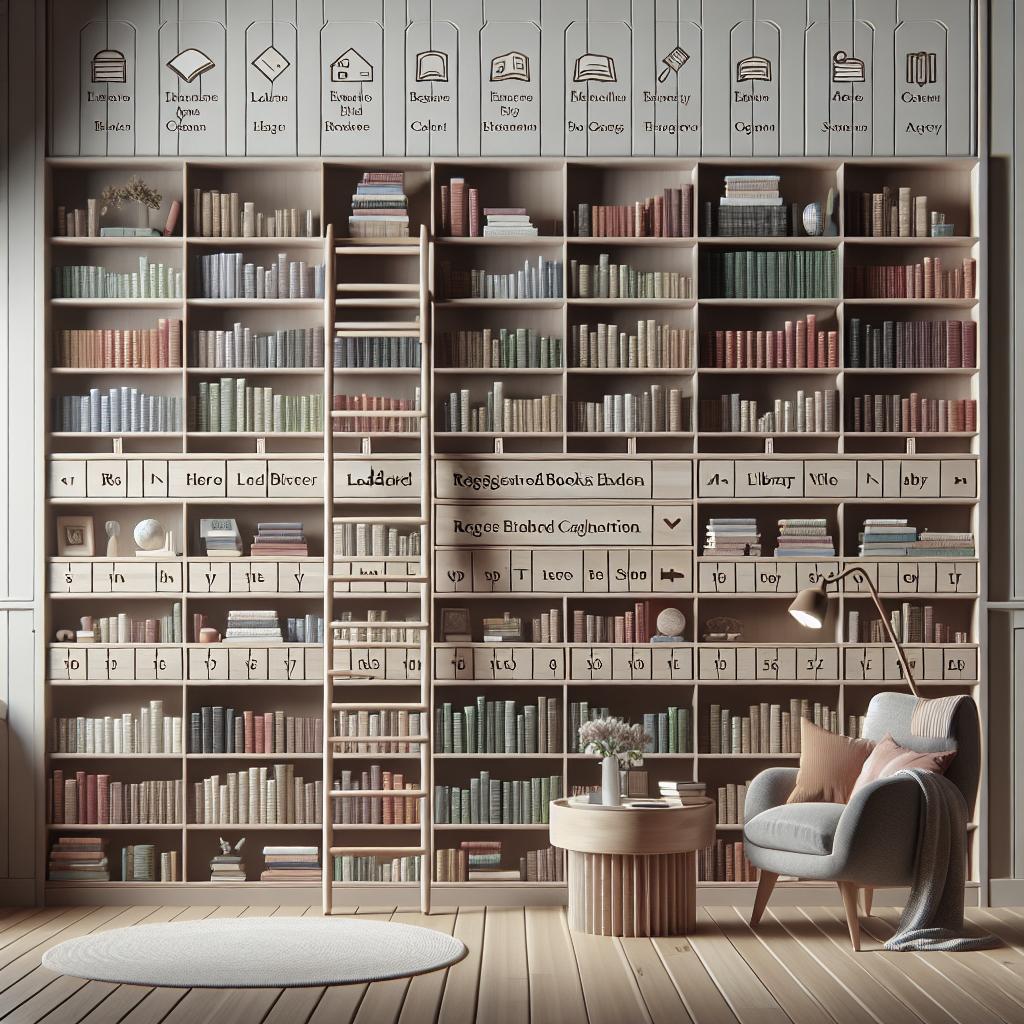“`html
How to Organize a Home Library Efficiently
Creating a well-organized home library can transform your reading experience and enhance your living space. This guide will walk you through the essential steps to achieving an efficient library setup in your own home. From assessing your entire collection and strategically placing books around your house, to using vertical space and categorizing by theme, every essential tip is covered. Additionally, we will explore digital tools for cataloging and how to strike a perfect balance between aesthetic appeal and practical function. Finally, special emphasis is placed on organizing children’s books to nurture a lifelong love of reading. Let’s dive into a world of order and inspiration!
1. ASSESS YOUR ENTIRE COLLECTION
Before organizing your library, it’s crucial to conduct a comprehensive assessment of your current collection. Start by pulling all your books off the shelves—yes, all of them. This might appear daunting, but it provides an exhaustive overview of what you own, enabling you to make informed decisions on what to keep, donate, or sell.
As you scrutinize each title, consider both sentimental and practical value. Ask yourself if each book still speaks to your interests or if it was a fleeting curiosity at the time of purchase. Sorting through your collection can be cathartic, clearing both physical and mental space for new reads that align with your current tastes.
2. PUT BOOKS WHERE YOU NEED THEM MOST
Once you’ve distilled your collection, think strategically about book placement throughout your home. Books related to a particular activity should be stored near where that activity takes place. For instance, cookbooks belong in the kitchen, while instructional books such as yoga or meditation guides can be placed in the exercise area.
Leisure reading and novels can enhance spaces meant for relaxation like the living room or a cozy reading nook. For those who work from home, consider adding professional reference materials to your home office shelf. This approach not only maximizes the utility of your books but also keeps them within reach when you need them most.
3. TAKE ADVANTAGE OF VERTICAL SPACE
When space is limited, the only way to go is up. Vertical space can be a game changer for home library organization, especially in smaller living areas. Floor-to-ceiling bookshelves or installing wall-mounted shelving units can provide ample space to display and access your favorites without overcrowding the room.
Don’t forget the often-overlooked high storage potential of corners or narrow hallways. Adding ladder-style or floating shelves in these areas allows you to expand your library without losing valuable floor space. Just ensure the structure is safe and secure, especially in households with young children.
4. GROUP SIMILAR BOOKS INTO SECTIONS AND SUB-SECTIONS
To facilitate easy access and a visually appealing arrangement, consider grouping your books into sections and subsections based on similarities. Categories like fiction, non-fiction, biographies, and reference can be further divided into themes, authors, or genres.
Beyond thematic organization, you could explore other systems such as color-coding for aesthetic appeal or arranging by size for a streamlined look. Tailor the system to your preferences—what matters is that it enhances your interaction with your collection and ensures you can quickly locate any book you wish to revisit.
5. TRY A CATALOGING APP
In the digital age, cataloging apps offer an efficient way to keep track of your literary inventory. Applications like LibraryThing, Book Catalogue, and Goodreads allow you to register your entire collection, rate books, and create wish lists for future purchases.
Harnessing technology not only simplifies the cataloging process, but also enriches your reading experience through community interactions. You can discover new titles, participate in book clubs, and see how your library stacks up against others. For meticulous organizers, features like tagging, metadata editing, and integrative tools with e-book devices make these apps invaluable.
6. STRIKE A BALANCE BETWEEN FASHION AND FUNCTION
A home library reflects your personality and tastes, so it’s important to find a satisfying balance between fashion and function. Aesthetic considerations like coordinated decor, decorative bookends, or integrating artwork alongside books can transform a typical shelf into a visual masterpiece.
However, don’t let style undermine accessibility. It’s crucial to maintain easy access to the titles you frequently revisit. Remember that your library is a living space—one where beauty enhances but does not compromise practicality. Consider integrating dynamic elements like seating or even small potted plants to make the space inviting and usable.
7. ORGANIZE KIDS’ BOOKS TO INSTILL A LOVE OF READING
Instilling a love of reading in children starts with making their books accessible and inviting. Dedicate a bookshelf exclusively for children’s books, placing it at a height accessible for your little ones. Having their collection within reach encourages independent exploration and choice.
Use baskets or bins for tiny hands to easily pull out books and stow them away after reading. Group books by theme or character to align with their interests, sparking curiosity and facilitating thematic reading adventures. As your child grows, invite them to participate in reorganizing their collection—turning it into an enjoyable and educational activity.
Next Steps
| Step | Description |
|---|---|
| Assess Your Entire Collection | Thoroughly review and decide what to keep, donate, or sell. |
| Put Books Where You Need Them Most | Strategically place books around their relevant activity areas. |
| Take Advantage of Vertical Space | Utilize vertical and often forgotten spaces for shelving, maximizing storage. |
| Group Similar Books Into Sections and Sub-Sections | Organize by theme, genre, or author for easy access and aesthetic appeal. |
| Try a Cataloging App | Utilize digital tools to track, organize, and enhance your reading experience. |
| Strike a Balance Between Fashion and Function | Ensure your library is both aesthetically pleasing and functional for daily use. |
| Organize Kids’ Books to Instill a Love of Reading | Create inviting, accessible spaces for children’s books. |
“`
